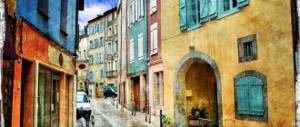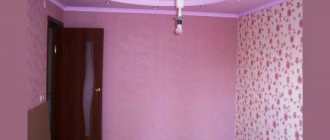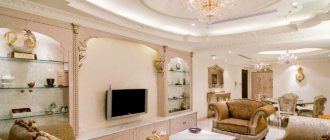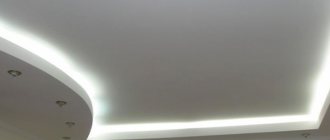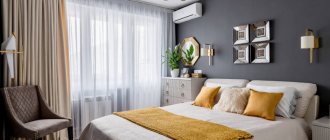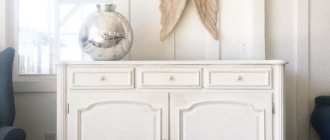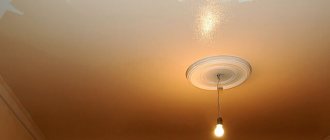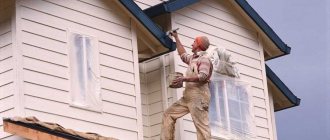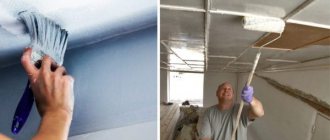Today, textured wall paint is very popular among finishing materials. With its help, you can achieve a relief surface, create a unique texture, and even save on preparatory work. The consistency of the paint is very dense and viscous; when applied, the thickness of the coating is much greater than that of conventional paint. Consequently, the time for preparatory work is reduced, since there is no need to perfectly level the surface of the walls. If desired, this paint can be used for the ceiling.
Main advantages of the material
The texture dye contains a binder acrylic polymer. Thanks to this, the material has the following qualities:
- used for both external and internal work;
- with increased moisture resistance, resistant to temperature fluctuations and precipitation;
- prevents the appearance of mold;
- durable, resistant to chemical influences;
- decorative relief is not modified;
- easy to care for, environmentally friendly;
- used for texturing walls with uneven surfaces;
- By adding color pigment it is possible to achieve any shade.
On video: how to apply the Fur coat effect.
Types of paint and popular brands
Texture paint for walls is divided into categories that differ from each other in composition; with its help, a relief texture is achieved:
- finishing composition for facade surfaces;
- textured painting material for interior decoration;
- universal paint (for interior and exterior use);
- fine grain dye;
- texture paint with coarse composition.
When choosing a material for decorative painting of walls (or for the ceiling), you should not give preference to cheap compositions. First, consult with professional builders who have been performing finishing work for many years.
- "TEX Universal" - paint intended for interior and exterior decoration. Can be used to cover walls in the bathroom and kitchen, as it has increased moisture resistance. The durable composition of the paint allows it to be applied in one layer to cement or concrete surfaces.
- “Optimist” is an acrylic-based material, also intended for exterior and interior use. Its spectacular texture will help hide minor wall defects.
On video: a tutorial on applying decorative materials Optimist.
What paint to paint the walls in the apartment
What paint is better to paint the walls in an apartment - features of materials and installation rules
Figuring out which paint is best to paint the walls in an apartment is not as easy as it seems. The choice of materials is huge, and the marketing policy of manufacturers does not help educate consumers in technical issues and the real characteristics of the product.
We will tell you what is the best way to paint the walls in an apartment, and also discuss the rules for applying paints.
Apply the coating with a roller in a thin layer.
We wait for the first layer to dry and repeat the procedure. If after this the color is not bright and saturated enough, apply a third layer of material.
Important! All three layers must be thin and even, this is a prerequisite.
When painting walls, the correct choice of materials and correct surface preparation are important. With the help of the video in this article and our instructions, you will easily cope with this task, because painting work is simple and accessible to everyone.
What paint is best to use for decorating walls in an apartment?
Painting walls remains one of the most popular options for finishing them. But, giving preference to it, you should remember that the chosen paint for the walls in the apartment can equally become both the highlight of the completed renovation and its gravestone. That's why this choice needs to be taken very seriously.
Basic rules when choosing paint
Today in construction supermarkets you can choose wall paint of almost any color and shade, and even with a variety of effects: from imitating stone and wood to marble and golden shades. In such a variety, it’s easy to get confused and choose something completely different from what you need.
It’s one thing to paint the inside of your home, but quite another to paint the exterior of your home. It is unlikely that paint intended for painting concrete or brick walls will be able to beautifully and correctly paint a wooden house. And inside the house, the material used to paint walls in the living room or children's room is not suitable for painting bathroom walls.
All these nuances need to be known and taken into account. Therefore, before painting the walls, you need to draw up a work plan in which you indicate the main details: the type of room (kitchen, bathroom, toilet, hallway, children's room, etc.), the total area of the walls to be painted, the material of the walls themselves and their finishes , the color and paint features needed for each room and the approximate total amount you plan to spend on paint. Only with such a plan at hand can you go shopping for material.
The main thing you should not skimp on when choosing paint is the safety of the purchased material, because you and your loved ones will spend a lot of time inside the house. Therefore, it is imperative to choose only high-quality products, although they are more expensive.
Marble paint in the interior of the room
There are paints designed separately for exterior and separately for interior use. There are also those that are suitable for both types of painting. But if you want to paint the walls in an apartment or residential building with high quality, then it is better to purchase the material separately.
Paint intended for indoor work is more environmentally friendly, and for facade work it is more resistant to external factors (high and low temperatures, humidity, etc.). This stability is achieved by introducing various additives into the composition, which are not always environmentally friendly. In combined formulations, these additives are also present, only in smaller quantities, therefore both environmental friendliness and durability will be lower compared to special formulations.
Moreover, painting the walls in the apartment will be of better quality if you choose special wall paint for this work. The fact is that the composition of this paint is specially selected, so it will not stain clothes if it accidentally touches the wall, and it will get dirty much less, moreover, it is not afraid of repeated cleaning with a damp cloth and even withstands periodic washing with a brush and soap.
Painting walls in a children's room
When choosing paint for living rooms: bedroom, living room, children's room, you should choose only vapor-permeable materials, since normal air circulation in these rooms is a very important condition for a cozy and comfortable stay.
Two more properties of paint compositions that do not directly affect the quality of painting, but can significantly speed up and reduce the cost of the repair itself, hiding power and thixotropy. The first indicator characterizes paint consumption per 1 m², the second - the ability of the composition to reduce viscosity under mechanical influence. Simply put, such paints do not remain in the can, do not flow from the brush, and do not form smudges when applied. That is why they are considered the most convenient to use.
Types of wall paints
To make it easier to navigate the variety of colors, they are all divided into several types:
- water-based;
- acrylic;
- latex;
- oil;
- silicone;
- alkyd enamels.
Mixing paint with color
Water-based (or water-soluble) paints are considered the most economical of all existing types. In such paints, ordinary water acts as a solvent, so they have virtually no odor and have a short interval before complete drying. They are made on the basis of PVA, latex and acrylic resins. All water-based paints are classified as vapor-permeable materials. Such paints practically do not absorb dirt, and they are easy to wash off from the surface. But it is impossible to use water-based paints in rooms with high humidity: constant contact with water destroys the structure of the applied paint layer, therefore, repairs in such rooms will have to be done much more often.
Acrylic paints dry quickly and have no unpleasant odor. When dried on a painted surface, they form a matte hard film that is resistant to moisture and abrasion, so it is best to paint bathroom walls and wooden houses with them. Acrylic paints lend themselves well to tinting, and they can be tinted not only in special centers, but also with your own hands.
It is better to paint wooden houses with silicone paint
The main advantage of latex paints is their increased abrasion resistance. On a painted surface they form a thin but very durable film that evenly covers all the protrusions and depressions of the surface. Latex paints are applied in a very thin layer, so consumption will be minimal. They are well suited for painting textured plaster. They are also often used to repaint non-woven wallpaper if there is a need to renew or change its color.
The main advantages of silicone paints are their high vapor permeability and the formation of a water-repellent film on the painted surface. They are used mainly for exterior work, especially if you need to beautifully and correctly paint a wooden house.
Oil paints are considered “yesterday”. They consist of natural or artificial drying oil and pigments dissolved in it. Previously widely used for both exterior and interior applications, they are strong and durable and can be used on a variety of surfaces. But oil paints take a long time to dry, do not allow air to pass through, and they also have a characteristic unpleasant, pungent odor. Therefore, painting a house today is much easier and faster with other types of paints.
Acrylic paint is used to paint the bathroom
For similar reasons, painting walls in an apartment or residential building with alkyd enamels is not recommended. They, like oil ones, are vapor-tight and have a specific, persistent odor. They differ from other types of paints in the drying process. When they come into contact with air, they undergo an oxidation process that leads to drying, while other types of paints dry due to the evaporation of the solvent.
How to paint walls
Regardless of the choice of paint type, high-quality preparation of walls for painting is very important for a high-quality final result. Its main requirement is that the wall surface must be cleaned of dirt and dust, and the finishing materials (if any) have strong adhesion to the main surface.
Painting walls with a compressor
For high-quality painting of walls, not only high-quality paint is important, but also high-quality tools, especially since their list is very short:
The choice of tool depends on the area and topography of the wall to be painted. For example, it is advisable to use a painting compressor in cases where you need to paint a flat surface of a large area. If you need to paint a relief surface, then in this case there are no alternatives other than choosing a brush. If the most important thing for you is not the speed of painting, but its quality, then it is best to use a roller.
When painting with water-based paint, you need to use a roller made of natural fur.
Therefore, the question of how to properly paint a surface always requires an individual solution.
For example, when using water-based paint, you cannot use synthetic rollers, incl. and the most common foam rubber. During operation, all these materials will leave air bubbles in the applied paint layer, reducing its integrity and deteriorating its quality. Therefore, you need to purchase a roller made of natural fur or, if possible, a compressor for painting. It will be much faster to use than a roller.
The seemingly routine process of painting walls is an interesting and creative activity that allows you to show your individuality and give room to your imagination.
How to choose the right paint for the walls in your apartment?
- Materials suitable for wall decoration in the bathroom
- What types of paper wallpapers are there for walls?
Modern interior decoration: what paint to paint the walls in the apartment
Fashions for types, styles, design ideas in the design of wall surfaces are constantly changing.
If quite recently wallpaper was considered the most popular way to decorate walls, today everything has changed dramatically.
Paint and varnish materials are used in any repair. It is impossible to imagine this process without them.
Today, when samples of a new generation have appeared on the building materials market, paint has become even more often used, including in wall decoration.
The main thing is to decide what paint to paint the walls in the apartment, and then it’s a question of technique. Moreover, this style of decoration today occupies far from the last place.
What are the advantages and disadvantages of painting walls?
A significant advantage of this type of finishing is the cost - this is the most budget-friendly technology for protecting wall surfaces and design style.
Painted walls in the interior
Painted walls can complement any design project, but this is far from their only advantage; the most significant ones are:
- Wide variety of finishes. With the help of paint, you can turn the most daring and original design ideas into reality: combining different tones, emphasizing individual areas and zones with shades that are radically different in color palette, applying drawings to the walls, and so on.
- A high-quality paint and varnish coating, when applied correctly, protects walls and gives comfort and warmth to the room. Does not lose its original qualities throughout its entire service life.
- Painted walls are not attractive to pets, and this eliminates the risk of damage and scratches.
- Caring for a painted wall is the easiest, without losing its original appearance.
- This is the simplest and most rational type of wall decoration. if the room has a non-standard or very complex geometry: the presence of numerous niches, slopes, figured protrusions, and so on. Compared to panels and even wallpaper, painting is the easiest and fastest way to decorate.
- After repairs, a certain part of the paint and varnish material always remains in stock. This makes it possible to eliminate minor defects and minor damage to the wall: a stain, a small scratch, abrasion or a chip.
- If the selected color becomes boring after a certain period of time, you can change it to a new one at any time. In this case, there is no need to prepare the wall surfaces again.
The disadvantages of this finishing method include:
- Paint does not hide defects on the walls; far from it, it can highlight them. Therefore, the preparatory stage must necessarily consist of the ideal alignment of their surfaces.
- The dyeing process itself involves some difficulties. If a person is not at all competent in painting, has no experience, and does not follow the recommendations for choosing a quality product, using the cheapest one, then the end result may appear in the form of unevenness, smudges and inconsistencies in texture or shades.
- Painted walls do not like point impact, especially mechanical impact. Therefore, with frequent or careless use, abrasions, scratches and small chips may form on them.
- In fact, all types of wall paints and varnishes, except glossy ones, are capable of accumulating dust and dirt on their surfaces. This fact should be taken into account when choosing this design method and not use them in heavily smoky or dusty rooms.
Preliminary preparation of the wall surface and its features
Applying paint to the wall is the easiest part of the job. Preliminary preparation is much more difficult: the correct choice of composition and leveling of the walls. How to properly prepare walls for painting different textures:
- Walls and concrete or brick must be plastered. It is best to use a sand-cement composition as the material.
- After plastering, the walls need to be primed and leveled with finishing putty. It is best to use a gypsum composition, it gives minimal styling and dries faster. For bathrooms, toilets and kitchens, it is better to use polymer waterproof putty or cement-based putty.
- After the finishing layer has dried, it should be sanded well with sandpaper and the dust should be swept away.
Having done all the above work, you can start painting. Let's talk in more detail about what paint to paint the walls in the apartment instead of wallpaper.
What type of paint should you choose for painting walls?
When choosing the right types of paints, you should start from the chemical structure of the composition. After all, the difference between them is significant; not all of them can be used to paint walls inside an apartment.
This type of paintwork material is very often confused with the previous composition due to its similar consistency.
This is a mistake and the difference between them is significant.
The binding component of alkyd paint is alkyd resin.
It is made from vegetable oils using acidic components strictly according to special technology.
Solvents for them are: turpentine, gasoline, white spirit solution and other volatile substances.
After applying the alkyd substance to the wall, solvents do not evaporate very quickly, since they are considered volatile, and a durable film tinted with pigment is formed from the resin. Due to the presence of binder resins in it, the coating is characterized by:
- Good elasticity
- Resistant to humidity and ultraviolet
- Temperature changes
- Excellent hiding power
- Vapor permeability
Although the latter indicator is considered a good quality advantage, it is not very pronounced, so using it in a residential apartment is not considered the right decision. Another disadvantage is the strong odor and fire hazard.
Coloring composition based on household solvents and mineral oils. If earlier it dominated in repair work (there were simply no alternatives or competitive materials for this coating material), today it is practically forced out of the building materials market.
After applying this composition to the surface, it tends to oxidize, leaving a coding film layer when drying:
- The durability of this coating is low
- Takes a lot of time to dry
- After several years of use, the coating loses its original appearance.
- May crack
- The film layer of the coating does not allow water vapor to pass through, and this is very harmful for the microclimate of the room where this composition is used
The only positive property of oil paint is its low cost.
Silicate
Composition of mineral components, the base component is liquid glass.
- After drying, it forms a durable, strong coating.
- Resistant to abrasive substances and loads
- Characterized by the highest, in comparison with others, paintwork materials
- Vapor permeability
- Resistant to the effects of orphans
- Fungal colonies or mold do not form on the coating
Butadiene-styrene
Very rare. Treat this type of paint with caution. This subspecies is considered one of the varieties of latex paints and varnishes.
Similar to a water-based substance, but much more resistant to wear, “hydrophobia” and abrasion. They are best used as a primer, as a topcoat. It's better not to use it.
Water-based
This is the largest group of paints and varnishes and one of the most optimal options for use in decorating the walls of a residential apartment. Despite the fact that the group includes different types of substances, they are united by a single property - the most common water is used as a solvent.
In a suspended state, regardless of the type - emulsion or dispersion, all the necessary substances are present:
- Binders - after drying they form a durable film coating
- Color pigments used to give a specific shade
- Technological additions that serve to simplify the painting process, improving the plasticity of the coating
- Special additives designed to impart stability to the coating during operation and mechanical stress
Polyvinyl acetate
Based on a PVA adhesive component. They are considered the most budget-friendly, easy to use, and have good adhesion.
It does not emit sharp unpleasant pungent odors, is safe for the body, and is easy to tint. Not very high resistance to abrasive substances or loads, as well as to high humidity. It is positioned as an economical, but far from practical coating.
Latex water dispersion
Foaming substance based on latex components:
- After drying, due to polymerization, it forms a fairly durable protective layer.
- Resistant to abrasion and high humidity
- Characterized by moderate vapor permeability
- Does not form condensation on its surface
- Fits perfectly on walls
- Has high hiding power
- Smoothes out minor defects in wall surfaces (no more than 1 mm)
In terms of resistance to ultraviolet radiation, it is second only to silicone and acrylic analogues. It is considered an expensive material.
They occupy a leading position in both price and quality categories. This is the most popular and most affordable type of paint used in finishing walls and ceilings. The reasons for such wide popularity of this particular subspecies are:
- Unique resistance to tinting. The acrylic resins included in its composition interact well with coloring pigments and are not affected by them.
- High resistance to ultraviolet radiation and abrasion; during operation, the coating does not fade, does not lose its shine or original attractiveness.
- It is equally good for painting walls and ceiling surfaces.
- Endowed with excellent coverage, does not leave streaks or streaks.
He does not have any serious negative qualities.
Silicone
Water-dispersed composition of the latest generation. Endowed with virtually all of the above advantages. A definite answer to the question of what paint to paint the walls in an apartment without streaks. It is considered the most versatile, suitable for decorating walls in any room.
- Has excellent hiding power
- Resistant to temperature changes and humidity
- Does not collect or absorb dust and dirt
- Endowed with excellent steam resistance
- Does not lose its original appearance throughout its entire service life
- Harmless to the body because they do not release toxins
They are considered the most expensive and this is their only drawback.
What type of paint to give preference to when choosing - recommendations from an experienced painter
When buying paint for wall decoration, you need to ask yourself a number of questions before giving preference to any of the above types, you need to take into account the functionality of the room:
- For hygiene room with high resistance to humidity
- For the kitchen, wash-resistant and easy to clean
- For bedrooms and children's rooms - environmentally friendly, safe for health
Then decide on the texture of the walls and the cost of the material. It is very important to pay attention to the manufacturer’s label when purchasing.
There should be a clear and clearly written note such as “paint intended for walls.” It is very important to take into account the degree of preparation of wall surfaces for painting:
- Matte with silk effects can smooth out and visually disguise minor imperfections.
- Gloss, on the contrary, will emphasize their presence and draw the attention of prying eyes to them.
The most suitable and best in painting walls are:
- Water-based compositions
- Acrylic
- Latex
- Silicone
- Alkyd enamel
Painting apartment walls with acrylic paint is considered the most affordable, rational and correct solution.
Correct paint calculation and other useful tips
Paint consumption depends on:
- Covering power of the substance
- Size of area to be painted
- Number of planned layers
- Degree of preparedness of wall surfaces
It is easy to calculate the area to be painted. It includes the height of the walls + perimeter - door and window openings.
On each can, the manufacturer indicates the weighted average size of the area to be painted in one layer. True, there are certain nuances here - on some packaging there may already be indicators in square meters, on others - millimeters per square, on others - kg per square.
It is important here not to confuse a liter with a kilogram - they are not the same thing - they cannot be equated.
Wall painting process
The number of layers can be determined by experimentation.
You need to understand that applying the primary layer will require approximately 15% more paint than all the others.
It is not recommended to apply paint to an uneven surface that has not been prepared in advance.
Professional painters consider such an action to be pure sloppiness and wastefulness.
In this case, it is virtually impossible to determine the absorption of the coloring composition.
Correct arithmetic calculations will allow you to calculate the material consumption as accurately as possible. Alternatively, use an electronic calculator.
Compliance with the listed recommendations in terms of choosing paint and preliminary preparation of wall surfaces will allow you to achieve the effect that you expect from the chosen coating.
When purchasing, do not forget to pay attention to expiration dates, storage and use - a lot also depends on this. They are indicated on the packaging label personally by the manufacturer. Expired paints lose most of their properties, so the end result may be unpredictable.
Painting walls with paint - on video:
- How to paint wood with acrylic paint. Made by myself, homemade items, things made by hand. The Made by myself website contains a huge archive...
- Is it possible to paint with water-based paint over whitewash? Is it possible to paint with water-based paint over whitewash? Better not. Read why When painting the ceiling...
- What wallpaper can be painted and with what paint? How to paint non-woven vinyl wallpaper yourself Painting liquid wallpaper. Conclusion Wanting to make your…
- Materials for finishing walls in an apartment Modern materials for finishing walls in an apartment On the modern market there is a huge selection of materials for…
Tools and materials for work
To paint walls with texture paint you will need to purchase the following tools and materials:
- acrylic putty;
- primer;
- medium size spatula;
- cuvette (tray) for paint;
- rags;
- rollers (regular and structural);
- scraper;
- foam sponge;
- texture paint;
- workwear.
If you don't have a structure roller, you can easily make one yourself. For this you will need a rough rag. Attach the rag to the roller with thread and get to work.
Preparing walls for painting
The walls must first be cleaned of dirt. This can be done with water, detergent and a cloth. Use a spatula or scraper to remove any remaining old coating. If there are cracks or gouges on the surface, fill them with acrylic putty. Once completely dry, coat the entire wall with primer. Leave to dry for approximately 12 hours.
Preparation before painting is required. Texture material can hide only minor wall imperfections. And the primer will help the paint adhere more firmly to the surface.
Paint is usually sold in powder or liquid form. First, read the instructions, dilute the powder with water using a construction mixer, and mix the finished paint thoroughly. Now you can add color pigment or mix several paints to achieve the desired shade. The pigment should be added while mixing, so the consistency of the paint will be as uniform as possible.
Do a test job before starting painting. Make a few test strokes with a roller on a small piece of cardboard.
Options for the resulting effects
In the process of applying texture paint, you should consider: whether the pigment is selected correctly, whether it is compatible with the dye, and also choose the desired technique for applying the material. Thanks to these components, you can get a unique relief. Conventionally, finishing can be divided into several types:
- Marseille wax. Externally, the surface resembles a combination of tree bark and natural stone. After the texture paint has completely dried, it is necessary to cover the surface with wax. This will give the walls more depth and a luxurious effect.
- Relief. If you want to create a relief transition of small dots and thin strokes on the wall, sawdust and quartz chips will help you with this. Materials should be added to the paint and mixed thoroughly. It is not difficult to adjust the degree of relief. If a minimum surface grain size is required, sand can be added instead of quartz chips. Here everything will depend on your imagination.
- Atacama. To create a three-dimensional wall surface, it is necessary to add fine metal shavings and sand to the acrylic dye in equal proportions. This composition will create an optical illusion. From different corners of the room it will seem to you that the wall has a reflective velvety base filled with volume.
- Mizuri. The most popular type of surface coating. It's quite easy to achieve this effect. Water and modified starch are added to the paint. After drying, the wall becomes glossy. Sometimes a pigment filler is added to the composition, which allows you to achieve a pearly shine. The paint is applied to the wall in chaotic patterns, resulting in the effect of a wet lye.
Before painting, be sure to wear protective clothing and safety glasses. This will protect your eyes and body from paint.
Paint selection
There are no frankly low-quality water-based and acrylic paints on the market today, but gradation is still present, since not all compositions have an optimal price-quality ratio. Here is the rating for May 2020 for acrylic paints:
- Dulux 3D White,
- Luxury ECO VD-AK-22,
- Dulux Vinyl Matt,
- Alpina EXPERT Premiumlatex 3,
- Kapral B-12.
The composition Kapral B-12 has a gloss according to EN 13 300 and is classified as a deep matte paint. When applied correctly, it does not form smudges and is used for painting plasters, putties, chipboards and fiberboards. Corporal proved himself to be quite good when painting drywall after preliminary preparation. Used for rooms with normal humidity.
Alpina EXPERT Premiumlatex 3 is also a deep matte finish. The paint has a wet abrasion class 3, has good covering power and, when applied, retains the texture of the substrate (for example, corrugated wallpaper). Alpina of this brand is vapor-permeable and can be easily diluted with water when thickening or for the first layer. Contains pigments, acrylic copolymer and mineral filler.
Dulux Vinyl Matt is made in the UK so the quality is high by default. This is a fairly expensive paint, but it contains 0% organic volatile substances and excellent coverage. The material has minimal consumption and contains marble chips, which help hide minor defects on the surface. Can be used with equal success for painting ceilings and walls.
Don’t forget to immediately buy a paint tray and a rod for a roller - this is not only easier to work with, but also reduces material consumption.
The most original solutions
Let us introduce you to a few concepts. Of course, you shouldn’t blindly copy even the most original ideas. But they can always be taken as a basis and adjusted taking into account the characteristics of a particular room.
Accent wall or part of a wall
Highlighting one of the walls or part of it with a brighter color will help you decorate the room in an original way. Most often, the wall opposite the door or located on the right side of it is used as an accent wall.
Using this technique will allow you to divide the room into functional zones, as well as visually adjust the size of the room, visually “stretching” it in length or width.
Creating geometric shapes or polylines
They can be arranged in a thoughtful order or chaotically, thus obtaining an unusual original composition. Sometimes a couple of broken lines or even strokes are enough to make a monotonous wall sparkle with new colors.
To paint walls with water-based paint with a pattern, you need to use paper tape. It is stuck on the wall and outlined with a brush. Just remember to remove the strip in time. Completely dried water-based paint may crumble if you tug the tape sharply.
You can also create decorative designs on the wall using special rollers. There are many instruments on sale with small figures printed on them. But it doesn’t always make sense to completely cover the walls with such images - it’s better to paint individual fragments with them.
Creating textures
A worthy alternative to the traditional painting method is the use of a textured water-based emulsion. The effect of relief walls can be achieved by introducing finely ground sawdust, marble chips, sand, metal filings, etc. into its composition. You can create such paints at home.
The most popular types of textured water emulsion are:
- relief: its height is adjusted by changing particle sizes;
- “mizuri”: after drying, the wall acquires a slight shine; similar paints are obtained by introducing modified starch;
- “Marseille wax”: imitation of cork or tree bark; to create it, finely ground fabric fibers are introduced into the composition.
You need to get used to working with such paints by first practicing on a small area. Over time, you will be able to easily imitate the textures of stone or wood on the walls. To create them, you can also use special rollers with stamps applied to them.
Gradient (ombre)
This technique, popular back in the 70s, is coming back into fashion. But to implement such an idea, as in the previous case, experience will be required. To create color transitions, spray guns and airbrushes are used. When painting individual fragments, you can use rollers and brushes. Areas with different shades are pre-separated with self-adhesive paper. To get a noticeable effect, it is better to use not 2, but 3-4 colors at once.
You can beautifully paint walls with water-based gradient paint using:
- flow of tones from dark to light in both horizontal and vertical directions; Moreover, the lightening (darkening) can go in different directions;
- only the middle part of the wall is highlighted, while the corners are darkened; this technique helps to visually “round off” them;
- darkening in the center and lightening on the sides;
- creating drawings (panels): the most complex option, available only to professionals.
